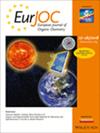通过DFT计算探索2,6 -二取代苯醌Diels-Alder反应的区域选择性
IF 2.7
3区 化学
Q2 CHEMISTRY, ORGANIC
引用次数: 0
摘要
用量子化学计算研究了2 -甲基- 6 -取代对苯醌的Diels-Alder反应。通过B3LYP‐D3、M06‐2X和DLPNO‐CCSD(T)方法研究了19个取代基(包括卤甲基、烷基、乙烯基、乙基、腈基、三氟甲基、甲氧基、环己基、苯基和三氟甲氧基)对反应势垒的影响。比较了两种区域异构体产物的吉布斯自由活化能。对于75%的取代基,计算出的势位差(ΔG‡b - ΔG‡a)与实验观察到的产物比a/b的值相差不超过2.0 kcal mol−1。从潜在变形和相互作用能的角度进一步分析了激活势垒。两种区域异构体对应的过渡态变形能差在−8.0 ~ +8.0 kcal mol−1之间,与实验ln(a/b)值成正比。相比之下,区域异构体过渡态之间相互作用能的差异要小得多。本文章由计算机程序翻译,如有差异,请以英文原文为准。

Exploring the Regioselectivity of Diels–Alder Reactions of 2,6‐Disubstituted Benzoquinones through DFT Calculations
Diels–Alder reactions of 2‐methyl‐6‐substituted‐p ‐benzoquinones are studied using quantum chemical calculations. The effect of 19 substituents, including halomethyl, alkyl, vinyl, ethynyl, nitrile, trifluoromethyl, methoxy, cyclohexenyl, phenyl, and trifluoromethoxyphenyl groups, on the reaction barriers is explored by the B3LYP‐D3, M06‐2X, and DLPNO‐CCSD(T) methods. Gibbs free activation energies are compared for the two regioisomeric products experimentally observed in the reaction mixture. For 75% of the substituents, the calculated barrier difference (ΔG ‡ b – ΔG ‡ a) lies within 2.0 kcal mol−1 of the value determined from the experimentally observed product ratio a/b. Activation barriers are further analyzed in terms of the underlying deformation and interaction energies. The difference in deformation energies of transition states corresponding to the two regioisomers ranges from −8.0 to +8.0 kcal mol−1 and is directly proportional to experimental ln(a/b) values. Differences in interaction energies between regioisomeric transition states are, in comparison, significantly smaller.
求助全文
通过发布文献求助,成功后即可免费获取论文全文。
去求助
来源期刊
CiteScore
5.40
自引率
3.60%
发文量
752
审稿时长
1 months
期刊介绍:
The European Journal of Organic Chemistry (2019 ISI Impact Factor 2.889) publishes Full Papers, Communications, and Minireviews from the entire spectrum of synthetic organic, bioorganic and physical-organic chemistry. It is published on behalf of Chemistry Europe, an association of 16 European chemical societies.
The following journals have been merged to form two leading journals, the European Journal of Organic Chemistry and the European Journal of Inorganic Chemistry:
Liebigs Annalen
Bulletin des Sociétés Chimiques Belges
Bulletin de la Société Chimique de France
Gazzetta Chimica Italiana
Recueil des Travaux Chimiques des Pays-Bas
Anales de Química
Chimika Chronika
Revista Portuguesa de Química
ACH—Models in Chemistry
Polish Journal of Chemistry.

 求助内容:
求助内容: 应助结果提醒方式:
应助结果提醒方式:


